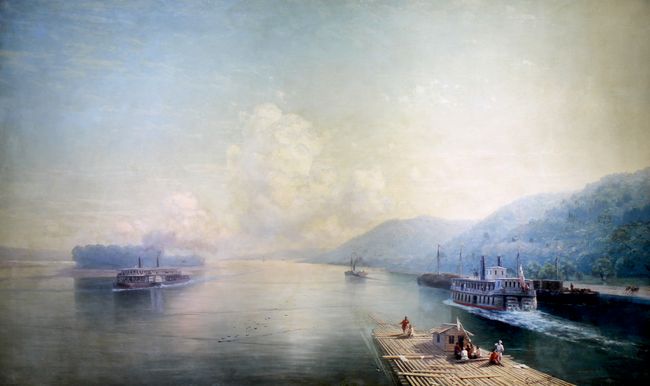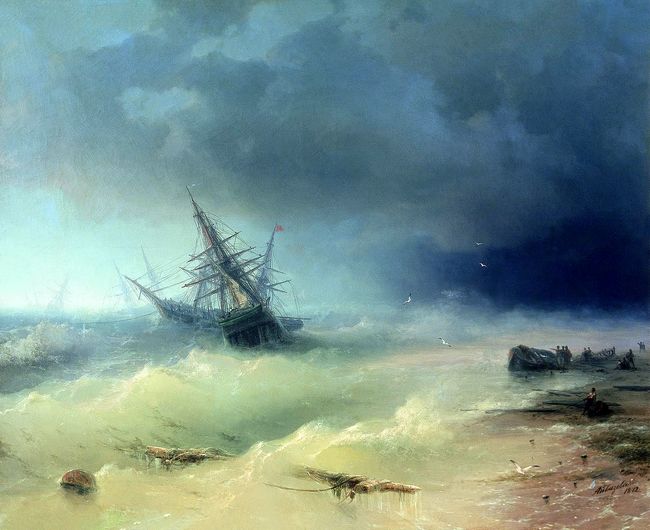The exposition, titled “The Genius and the Sea: Traditions, Searches, Discoveries,” marks the 200th anniversary of Ivan Aivazovsky’s birth and the 95th anniversary of the Kyiv museum. Most of the exhibited pictures (about 50 canvases by 18th-20th-century marine artists, including the famous Volga near the Zhiguli Hills by Aivazovsky himself) can only be seen here and now. Then the pictures will go back to museum storerooms.
For our contemporaries, seascapes are clearly associated with the female name of Marine. At the same time, the “portraits” of the sea – stormy or placid, sunlit or moonlit, under a lead- or melted gold-colored sky – is the most masculine genre in painting. Only men could become marine artists and, for that matter, sailors until recently. There is something very erotic in this. Even on canvases, the sea prefers the strong and forgives no sentimentality.
“All the works are exclusively from our storerooms, for we wanted to show again how unique our collection is and, therefore, did not invite our colleagues deliberately,” Yurii VAKULENKO, director of the Kyiv Picture Gallery told The Day. “The permanent exposition includes no more than five pictures out of those displayed at the exhibit. And some are being exhibited for the first time.”

IVAN AIVAZOVSKY, VOLGA NEAR THE ZHIGULI HILLS, 1887
The exhibit occupies the whole ground floor. But five halls proved to be not enough for a raging sea. For, ideally, a separate hall could have been given to just one picture – Storm (1872), the exhibit’s central canvas and the best of Aivazovsky’s works in the Kyiv museum’s collection. The same applies to the all too familiar Volga near the Zhiguli Hills (1887). This large-scale picture painted by the artist in Feodosia in fact closes the exposition, although it looks a little strange among Crimean landscapes by various authors. Yet there are “too many” items at the exhibit, which is good rather than bad for spectators. The National Gallery’s collection has a total of 18 Aivazovsky’s masterpieces. In addition to them and the works of our contemporaries, “The Genius and the Sea” also includes photos of the world’s best-known marine artist’s works the museum lost during World War Two as well as unique sea-related items from the collection of the Sheremetievs’ Museum.
“The Genius and the Sea” is not a new exhibit of Aivazovsky’s artworks. According to Vakulenko, this time the museum’s goal is to show the author of The Ninth Wave as a Ukrainian artist. “You can see, among other things, Ukrainian, including Crimean, landscapes. It is our land. Aivazovsky was at the origin of the Ukrainian landscape, not only seascape, and we have shown this,” the museum director says proudly.

IVAN AIVAZOVSKY, STORM, 1872
To tell the truth, you just… forget about the ethnic and other “sides” of the marine genius and his colleagues (the exposition also comprises Italian seascapes by Nikolai Ge, seascapes by Lev Lagorio and Konstantin Bogaevsky, very tender “Crimean” watercolors by Max Voloshin, etc.). The exhibit is worth visiting. In essence, “The Genius and the Sea” is an invitation to a grand and beautiful journey to the sea and to history, including the history of painting. Yet it is up to the viewer himself to determine which mental road is closer to him personally.
As is known, Aivazovsky was an avid traveler, and he usually painted his pictures from memory in his Feodosia studio. Taking this fact into account, exhibit curator Mariana Kruzhkova, a senior research associate at the National Museum of Kyiv Picture Gallery, grouped the canvases thematically, not chronologically. And each of the five halls turned into a “travel.” The first one offers an excursus into the history of marine art in this country. Apart from Aivazovsky’s famous Storm, you can see here, for example, the Crimean watercolors of the 18th-century artist Jean-Baptiste de Traversay (exhibited for the first time). The next halls are about sea battles and Italian landscape. And finally you are offered Crimea and a series of works by Aivazovsky’s pupils and successors.
What creates the strongest impression is the halls filled with works by the “sea genius” himself. The graphic sketches Calm (1850) and Storm (1850) leave an imprint by the mastery of graphic art. The oil-painted seascapes and landscapes, including The Acropolis of Athens (1887), impress with light – they seem to be illuminating the surrounding space. The “Italian” hall “with Aivazovsky” and contemporaries even visually looks lighter than all the others, as if lamps are more powerful here.
The sea does not like sentimentality but submits boundlessly to those who love it. Such was Ivan Aivazovsky who refused to exchange the sea for Saint Petersburg or any other city in any country of the world. “The Genius and the Sea” is also a travel through the great painter’s life story, where every chapter of his creative life is illustrated with reproductions of the master’s best-known portraits in each hall. Among them is the one the Uffizi gallery commissioned. But this is, so to speak, “a history in history,” “an exhibit inside the exhibit” for the cognoscenti.
The exposition will remain open until October 31.







